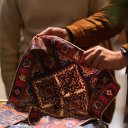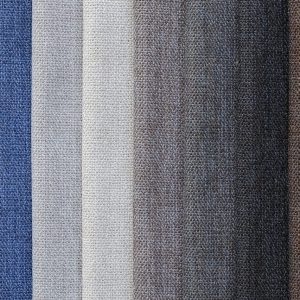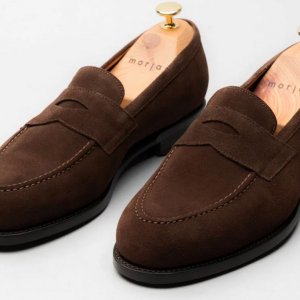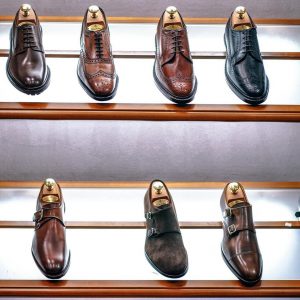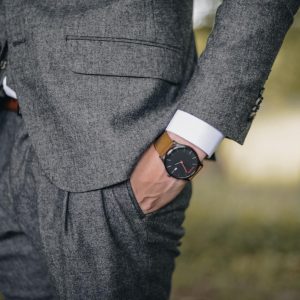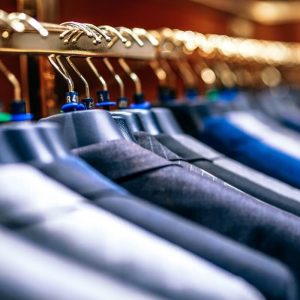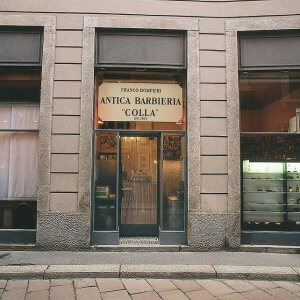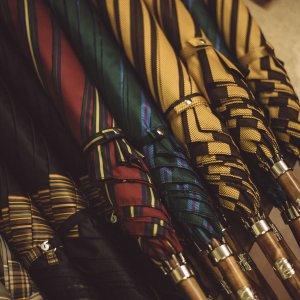Korbinian Ludwig Heß is a German shoemaker who is creating wonderful high-quality bespoke shoes for men and women by hand. Each shoe is a completely unique piece, which fits the customer perfectly and is made according to his/her wishes. Korbinian embodies the traditional values of craftsmanship: diligence, perfection, quality and a high degree of passion. This is also appreciated by his customers, who order his bespoke shoes from all over the world.
I was lucky enough to visit him in his workshop in Berlin Wilmersdorf and talk to him extensively about shoemaking and his professional career. Find out for yourselves what motivated him to become a shoemaker, what makes his bespoke shoes stand out and why you should definitely go to Wilmersdorf and order shoes from him. Thanks to the large window front, even a view from outside into his workshop is really fascinating! 😊
Korbinians professional career
Korbinian is originally from Munich and his life after graduating from high school was quite colourful and eventful. He tried out different academic studies (German and English, teaching degree with a focus on psychology and eventually therapy), which led him first to Vienna, then back to Munich and finally to Berlin. He has always had a soft spot for the Wild West and cowboys and after his last attempt to study he decided to open a cowboy saloon in Berlin with two other friends. The premises were chosen, with swinging doors and a long bar – just like you know it from Western movies.


Besides, the three guys wanted to sell matching hats and boots. This prompted Korbinian to google for cowboy boots shoemakers and he was surprised to find people who actually still carry out this craft in the traditional way. He found a shoemaker in Berlin who gave him a first insight into shoemaking. Korbinian soon realized that he had a great passion for it and he wanted more; he wanted to learn from the best in the world.
His shoemaker career
A short Google search led him to the list of the best shoemakers in the world at the time, which included the renowned Viennese bespoke shoemaker Rudolf Scheer. The idea of the cowboy saloon became history and he concentrated on getting an apprenticeship at Scheer. This turned out to be a pretty tough task. We can conclude that the approx. 9 months on Korbinian’s side required a lot of determination and enormous persistence. Finally, he was invited to Vienna for a week of trial work. After two days on site he was offered a permanent job. He stayed with Scheer for about two years and worked incredibly hard to learn as much as possible.
Korbinian is learning from the best shoemakers worldwide before opening his own workshop in Berlin
The phase after that was very diversified: the first attempt of self-employment in Munich, the short mentoring by the Swedish shoemaker Daniel Wegan (world champion in shoemaking 2019), outworker for the famous British shoemakers Gaziano & Girling, several months with Patrick Frei from Freiburg (world champion in shoemaking 2018), cooperation with Sascha Halm (absolute insider tip when it comes to Norwegian welted shoes!) in Leipzig and finally his own workshop in Berlin since April 2017.

Since May 2018 he has been employing the Japanese shoemaker Shigeki Motozuka, who deliberately flew to Berlin to apply for a job with Korbinian. He makes the uppers of all shoes in Korbinian’s workshop. At the beginning of 2020, the team has expanded with the American shoemaker Reid Elrod joining.
The shoemaking process
Bespoke shoes are manufactured exactly according to your wishes and perfectly fitting your foot. You can choose from a wide range of options: leather (boxcalf/ calf leather/ cordovan or more exotic varieties), colour, model, number of holes for lace-up shoes, brogueings, etc. The most important aspect in the process of making bespoke shoes is the last, i.e. the reproduction of your foot shape in wood.
Last contruction
When you have decided to go for bespoke shoes at Korbinian, you should allow a little time for the first appointment. The shoemaker will not only measure your feet, discuss your ideas and observe your gait. He also wants to find out as much as possible about you as a person and get to know you better. This will enable him to make the perfect shoe for you.
The last is the “shoemaker’s signature”
After this first meeting, he orders the raw last and carves it according to the measurements noted and your personality. As already mentioned, lastmaking is one of the most fundamental steps in shoemaking. Due to its importance, it is usually made by the boss, and you could also call it the “shoemaker’s signature“. It is a very complicated and unpredictable step that requires a lot of intuition.




Trial shoes and adjustments
The trial shoe is created based on the bespoke last. Korbinian usually makes two trial shoes; sometimes a third trial shoe is needed. This is very time-consuming, so the creation of a pair of handmade shoes can take between 80 and 120 hours! The customer comes over to try on the trial shoes, walks around and figures out if there is anything disruptive. Afterwards the trial shoe is cut open in some places so that Korbinian can “look inside” and check how the foot stands in the shoe. Just the selection of the points to be cut open is an art. Now you also know why you would never use the best leather for those tryout shoes.

After the first fitting, the shoemaker puts the last back into the shoe to mark the places which need adjustments. After this, the last is adjusted accordingly and if necessary, a second test shoe can be made. Korbinian has the requirement that the shoe must fit exactly as he would like it to fit. Often the customers themselves do not notice that there is still too much space in the front of the toes, for example.
The bespoke shoe
If both the customer and Korbinian are satisfied with the last fitting, the final shoe can be made. Only the highest quality leather is used, which must be stretched properly for the upper. This prevents the shoe from getting one size bigger after some time. It works best when the leather is completely wet. Korbinian relies on the highest quality method of making shoes: His shoes are all hand-welted, as this is the best way to ensure a perfect and comfortable fit. At the end of the process, a bespoke shoetree is made, which is essential for maintaining the shape of the shoe and for absorbing moisture. For a very detailed description of how handmade bespoke shoes are made, I recommend the book “Herrenschuhe nach Maß” by Bernhard Roetzel. Step by step the whole process is explained and illustrated with a multitude of photos directly from Korbinian’s workshop.



Interesting to mention is the heel of men’s shoes. Perhaps you have already seen for yourselves how spectacular the heels of high-quality shoes are. To achieve such an aesthetic and elegant result, single leather slices that are as thin as possible are required. The average heel height of men’s shoes is usually about 2,5cm. With Korbinian it can go up to approx. 3cm. The heel is indeed an important aspect because you can influence many things, such as posture.


You already read about Korbinian’s fondness for cowboy boots at the beginning of the article. This is also noticeable in his characteristic heels, which are a bit pitched. The heel is not completely straight at the back, but a bit bevelled. A feature you can also see in cowboy boots. According to Korbinian this leads to a special feeling when wearing them and is also more comfortable when walking.
What is so special about Korbinian’s shoes?
When holding one of Korbinian’s shoes in your hand, you will not recognize that they are coming from his workshop. Unless you have a really profound knowledge of the shoe characteristics by top shoemakers around the world and you can distinguish between the fine nuances of each artist. There is no logo, no inscription in his shoes. The reason for this is because they were created individually for one person and are therefore something very personal. A maximum of understatement! But you will also notice this understatement in his shoes in general. Korbinian makes rather reserved and simple models, without many perforations or buckles. Not without reason the wholecut is his preferred shoe and his motto is <Make the simple into something special>.



However, there are a few fine features that make Korbinian’s shoes recognizable. We have already spoken about the pitched heel. Basically, Korbinian would place himself stylistically (not only geographically) roughly in the middle between the East (Vienna/Budapest – more functional, massive, chunky, angular) and the West (France/England – more fine, elegant, round). This can also be seen, for example, in the toe area.
Of course, one cannot generalize here, as the original regional styles are becoming more and more mixed. But the more one goes to the east, the higher the shoe toes are. This is very practical when walking. The complete opposite would be the case with many French shoemakers, where there is hardly any space between the shoe toes and the ground. This is unbelievably elegant, but it can lead to a stronger walking crease. The toes of Korbinian’s shoes are a good compromise between the two and are set a little bit off the ground.
Learning from the Master directly
Korbinian Ludwig Heß is an absolutely passionate shoemaker. It is very important for him that you are able to recognize in a shoe the people who have made it. His employees are therefore encouraged to contribute and realize their own style.
Korbinian is offering shoemaking courses in his workshop in Berlin
He not only enjoys passing on his expertise to his employees. Recently he has also started offering shoemaking courses for interested beginners in his Berlin workshop. During the 12-day workshop, he explains how a bespoke shoe is made step by step. In this way one can intensively deal with the basics of this fascinating craft and get the perfect insight into the world of shoemaking. You can find more information on his homepage. Let yourself be inspired by his Instagram profile and get an even better impression of this passionate artist who is one of the best shoemakers worldwide!
Korbinian, thank you very much again for your time, the insights into your workshop and the very interesting and fascinating conversation! 😊
Photos by Martin Smolka and Tommi Aittala





